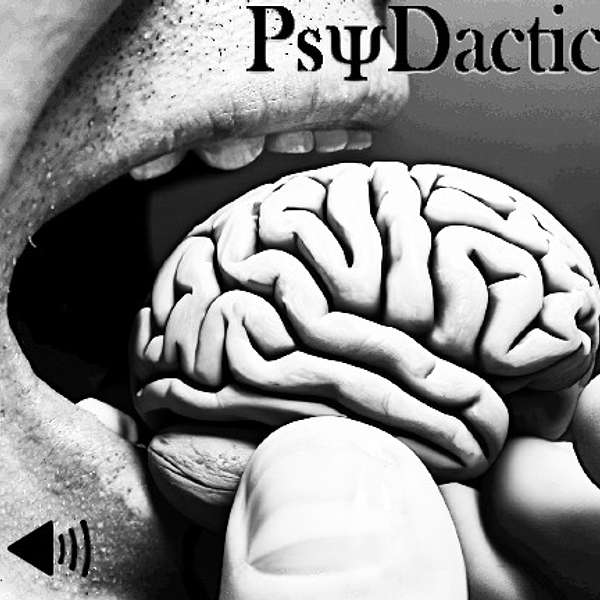
PsyDactic
A resource for psychiatrists and other medical or behavioral health professionals interested in exploring the neuroscientific basis of psychiatric disorders, psychopharmacology, neuromodulation, and other psychiatric interventions, as well as discussions of pseudoscience, Bayesian reasoning, ethics, the history of psychiatry, and human psychology in general.
This podcast is not medical advice. It strives to be science communication. Dr. O'Leary is a skeptical thinker who often questions what we think we know. He hopes to open more conversations about what we don't know we don't know.
Find transcripts with show-notes and references on each episodes dedicated page at psydactic.buzzsprout.com.
You can leave feedback at https://www.psydactic.com.
The visual companions, when available, can be found at https://youtube.com/@PsyDactic.
PsyDactic
Catatonic Signs - Stereotypy and Mannerisms
In the last episode, I promised [or threatened] to get into more of the nitty-gritty of the symptoms of catatonia. Well, like it or not, that is what I am going to do in this episode. Today I will focus on Mannerisms and Stereotypy, two of the potential signs of catatonia.
Please leave feedback at https://www.psydactic.com or send any comments to feedback@psydactic.com.
References and readings (when available) are posted at the end of each episode transcript, located at psydactic.buzzsprout.com. All opinions expressed in this podcast are exclusively those of the person speaking and should not be confused with the opinions of anyone else. We reserve the right to be wrong. Nothing in this podcast should be treated as individual medical advice.
Welcome to PsyDactic - Residency Edition. I am Doctor O and this is a short episode designed to give you a better understanding of some of the words we use in psychiatry. In the last episode, I promised [or threatened] to get into more of the nitty-gritty of the symptoms of catatonia. Well, like it or not, that is what I am going to do in this episode. Today I will focus on Mannerisms and Stereotypy, two of the potential signs of catatonia.
Catatonia can be conceptualized at least in part as a movement disorder. People with catatonia have trouble doing things, or do very odd things. That is why clinicians have described the retarded or akinetic cases and excited or hyperkinetic cases. But don’t get the impression that these cases are mutually exclusive. You may see in front of you a patient who is postering, cataleptic, with stupor, mutism, and waxy flexibility, but the day before he was running around his house apparently swimming through the air and repeating the phrase, “If you want to talk to me, I’ll have to ask Jon,” over and over and over again. Catatonia is under-diagnosed and under-treated. Patients are thought to be manic, delirious, or on substances. In fact, they may also be manic, or delirious and on substances and developing catatonia at the same time, so it should always be on your differential, especially if the assumed delirium is not getting better.
Movements are of great diagnostic power in psychiatry. Knowing the difference between tics and compulsions, akathisia and agitation, psychomotor retardation and parkinsonism is crucial for identifying the correct diagnosis and treatment. For example, if you mistake hyperactive catatonia for psychotic agitation and give increasing doses of antipsychotics, you greatly increase the risk of precipitating neuroleptic malignant syndrome.
I am going to start with two of the hyperkinetic symptoms of catatonia and define them from a neuropsychiatric point of view. Having clear definitions of what a behavior represents in terms of diagnostic signs, instead of vague concepts, is the best way to have more valid diagnoses and appropriately treat patients.
Let's start with Stereotypy.
Stereotypy is not a characteristic of some individuals that is generalized to a group. That is a stereotype, which may be a subject of a future podcast. Stereotypy a form of purposeless movements. Purposeless means they don’t accomplish a task. Like someone who takes a bite of cereal and then there's their head back and gurgles the contents over and over again. There is a rhythmic nature to them, which means that they repeat themselves in a way that is somewhat predictable. They also repeat themselves in a way that takes up an unexpectedly long amount of time. Imagine that someone is sitting in front of you and twiddling their thumbs. This is not necessarily all that odd, but if they continue to do it through a large portion of the interview, then you could classify that as stereotypy. Other things that may count as stereotypy are rocking back and forth (something I do on my feet during rounding or a particularly long conversation on my feet), but imaging that a patient is in a chair rocking forward and backward over and over and over and over again. Stereotypy is not specific to catatonia. It is present in the general population in mild forms, but patients with schizophrenia, autism, Trourettes and many other neuropsychiatric disorders often have higher levels of stereotypy than is expected in the general population. Imagine the pediatric patient with autism and head banking. Kids in general have high rates of stereotypy. For stereotypy to be a good diagnostic indicator of catatonia or other pathology, it should be something the patient would not normally do. For example, a patient is pacing the room with an arm folded across their chest and the other arm resting on it with their hand cupping their chin and their index finger tapping their cheek while asking themselves questions and referring to themselves in the third person. You ask their spouse, “Have they ever done this before?” and the spouse replies, “No.” They are displaying a caricature of a thinking position that is odd for them. The repetitive facial movements or pelvic rocking in tardive dyskinesia can also be described as stereotypy, though these may have a different pathophysiology. The keys to pathologic stereotypies are that they are odd, purposeless, rhythmic, repetitive, and to some degree predictable.
Mannerisms may be similar to stereotypies, but mannerisms are defined as peculiar purposeful actions that are unique to an individual. A more general word for this is an idiosyncrasy: something that makes the individual unique. It is the manner in which the individual does something that seems odd or peculiarv that makes it a mannerism.. These are different from stereotypies primarily because mannerisms are purposeful. Stereotypies lack purpose, and like stereotypies, mannerisms are not necessarily pathological. Most people probably butter their toast by moving the spreader from one side of the toast to the other. What if you saw someone buttering their toast by moving the butter in a spiral from the center? That's odd. Unless that is something common in their culture, then that would be a mannerism. It is performing a purposeful action in a strange way that is particular to that individual. If you saw someone picking their nose by first lifting the elbow above their head and then reaching down with their fingers upturned to get at that booger, then you are witnessing a mannerism.
Mannerisms can also be apparent in how people talk. We all have accents, but these are not necessarily particular to an individual. People often tell me I have a strange accent that they can’t quite place. That is because the manner in which I talk is funny. It is a mannerism. A mannerism is more likely pathological if it is odd, even for that individual. If a patient born and raised in Dubai suddenly starts talking in an imitated Texas accent, then this might be a pathological mannerism (no offense to Texas). Or your patient might just be drunk and a fan of Westerns.
To summarize, both mannerisms and stereotypies are odd actions. Mannerisms are apparent in the peculiar and individual way in which a person performs some purposeful action. Stereotypies are apparent by the rhythmic and repetitive way someone does something that accomplishes nothing. A hint to whether these are pathological signs is if they are not typical for that individual at baseline. They may be excessive or exaggerated or completely out of character.
In the next episode, I’ll continue defining the signs of catatonia in gorey detail and at some time I hope to try to pull it all together in understanding how the Bush-Francis catatonia rating scale, or something similar can be a good tool for tracking severity and progress.
Until next time, I am Dr. O, and this has been an episode of PsyDactic Residency Edition.
Podcasts we love
Check out these other fine podcasts recommended by us, not an algorithm.

Mindhunting: Journeys in Forensic Psychiatry
Dr Michael Schirripa
Brain Science with Ginger Campbell, MD: Neuroscience for Everyone
Ginger Campbell, MD
